Warwickshire, Worcestershire & South Staffordshire SHELDONS

SHELDON Parish near Birmingham
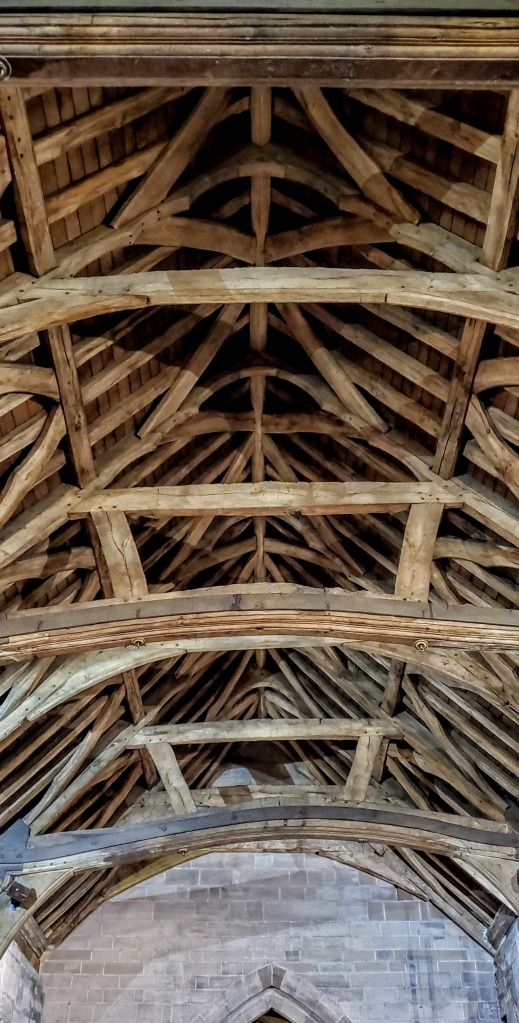
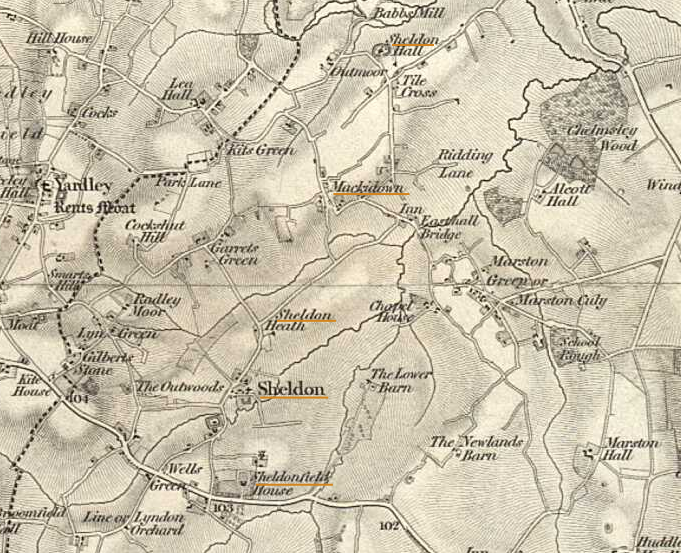
In the year 1086 SHELDON (known then as Machitone) was held by the Saxon overlord Turchill (Thorkill) and Alnoth was its tenant. In the Domesday Book the manor was known as Machitone, later Mackadown. The earliest record is of Owen de SCHELDON, who is listed in the Warwickshire Pipe Rolls of 1189/90 and the earliest record of the name’s use in Warwickshire. Perhaps Owen was the father or an ancestor of Ansel. The Anglo-Saxon Alnoth was succeeded by Ansel de SCHELDON, lord of “Makinton” in 1220, who held 1/2 knight’s fee from at least 1235-1242. The next Sheldon is a William son of Osbert de Sycheldon mentioned in a 13th century Conveyance. There was a moated manor house in Sheldon on Gressel Lane known as SHELDON Hall or East Hall. The standing SHELDON Hall, which is now Stonehouse pizza, dates back to the early 16th C.

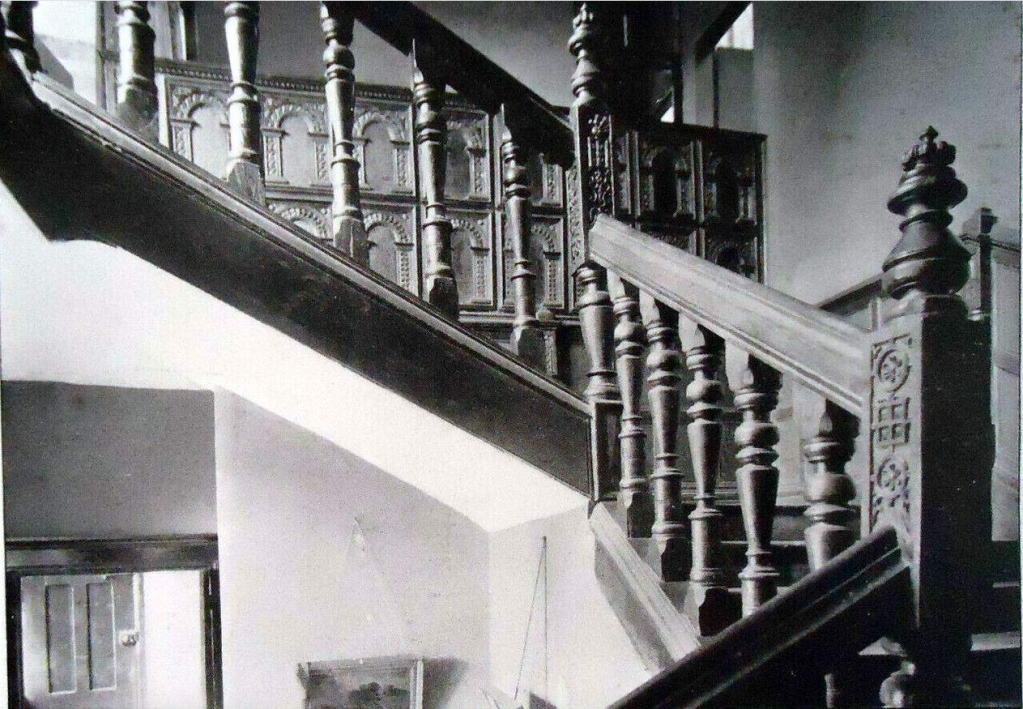
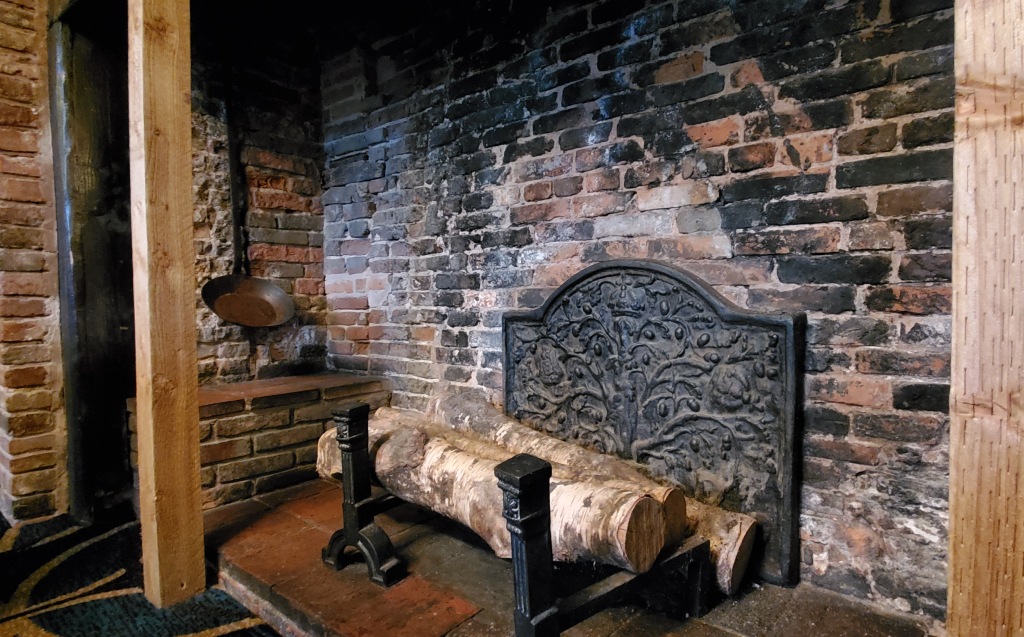
There was also a SHELDON West Hall at Kent’s Moat, but the Hall is no longer in existence. The buried earthwork remains of the medieval moated Hall lie adjacent to Sheldon Heath Road. The moat belonged to the Sheldon family who constructed a house here in the early 13th C and rebuilt it during the 14th century. The house was abandoned in the 15th C when it passed into the possession of the Earl of Kent.
The St. Giles SHELDON church and the village center lay in the center between the two SHELDON Halls. Ansel de SCHELDON was succeeded by his son Henry de SHELDON who was lord of SHELDON in 1288. Henry had the first church in SHELDON built about 1250 and dedicated to St. Giles. In 1260 Henry conferred a house and 2 acres to William SHELDON who was the parson of SHELDON. By 1315 Nicholas de SHELDON was the head of the family and also the parson of St. Giles Sheldon. In 1327 his widow Joan and son Henry SHELDON sold the manor and it passed out of SHELDON hands. It is believed that this is the root of all Warwickshire and Worcestershire SHELDONs and some in southern Staffordshire as well. Calendar of Close Rolls, Edward III: Volume 1, 1327-1330
“John SHELDONE of Birmingham… Enrollment of release by Henry to the said bishop for life of his right in the manor of SHELDON and in the advowson of the church thereof, and granting that the bishop shall have for life the reversion of all lands in the manor pertaining to Henry after the death of the tenants, excepting the lands that Robert, brother of Nicholas de Sheldon, Thomas brother of the said Robert, and Walter de Freynes hold in the manor, and that the aforesaid manor and advowson shall remain to the bishop’s executors in the manner stated in the preceding enrolment, rendering therefor to him after the bishop’s death 60s. yearly. Witnesses as in preceding enrolments. Dated at Lentou near Notingham, on 21 October, 1 Edward III. “
Note: more information can be found on Ken SHELDON’s website the SHELDON Chronicles. Links are bolded.
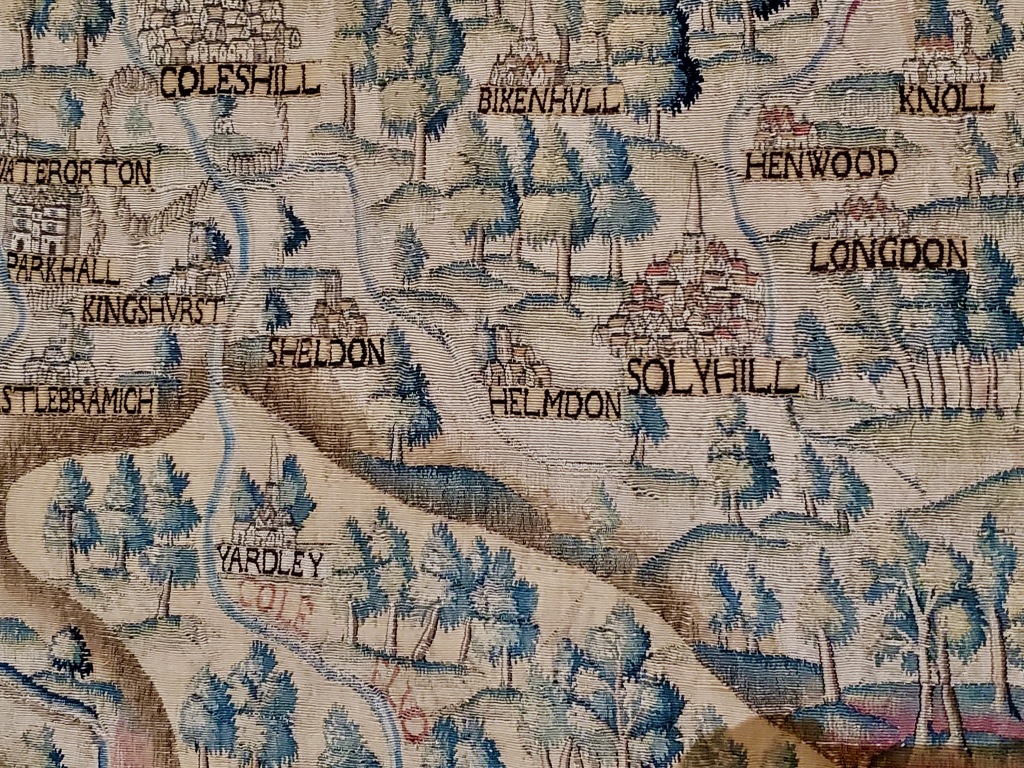
Note: to view the tapestries in relation to true north they must be rotated 90 degrees clockwise.
In the 1352 we find a late William de SHELDON owning a messauge in Henley (in Arden).
By 1419 A John SHELDON appears in Rowley Regis, Staffordshire from which a major branch of SHELDONs descend. About 1475 there is a John SHELDON, a grocer in London.
As you can see from the map below from the 12th C to the 16th C the SHELDONs moved from SHELDON, Warwickshire throughout Warwickshire and into southern Staffordshire, Eastern Worcestershire and Northern Oxfordshire and a couple more far afield like London and Manston, Dorset. The first major migration was to Rowley Regis as explored by Ken Sheldon in his article “The Black Death and the First Ralph SHELDON.”
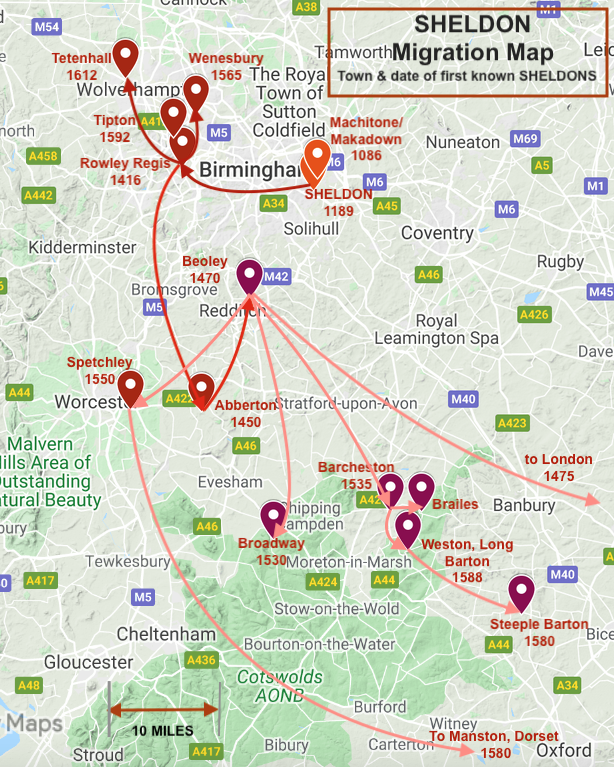
Below I will attempt to briefly note the towns where SHELDONs became prevalent by the 16th C. Rowley Regis, Abberton, and Beoley are the major hubs for the ancient SHELDONs. They will be treated first and then the rest in alphabetical order. For now I am clustering Wednesbury, Tipton and Tetenhall together under Wednesday.
ABBERTON SHELDONs
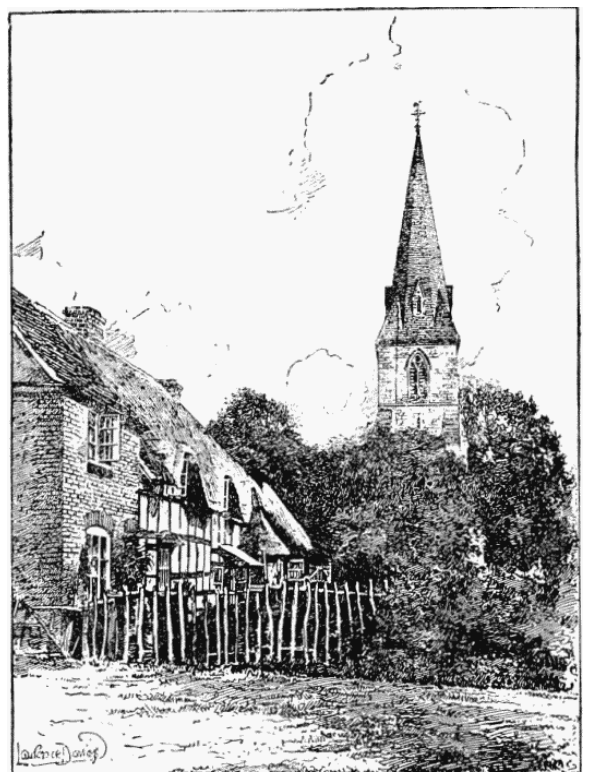
This branch of the SHELDON family was founded by John SHELDON (1380-1428) who married Johan Cotton. He was originally of Rowley Regis but removed to Abberton. To this union were born six sons, Richard, Morris, Daniel, John (of London), Ralph (of Beoley), William (of Abberton) (c1425-aft 1464) who died in Abberton,and a daughter Joan. John acquired properties in Spetchley, near Worcester, which Daniel inherited; Beoley, which Ralph inherited and the youngest son William held Abberton . Wiilam’s son Ralph SHELDON (1468-1546) married Phillipa Heath and was to be known as Lord of Beoley but he was born in Abberton. Quoting Ken SHELDON “Ralph’s property acquisitions enabled him to secure the futures of his sons while at the same time establishing new branches of the Sheldon family elsewhere. His second son, Baldwin founded the Broadway line of the family; Thomas was seated at Childswickham (a mile NE of Broadway, he died without issue)… Another brother, Francis, inherited the Abberton estate.”
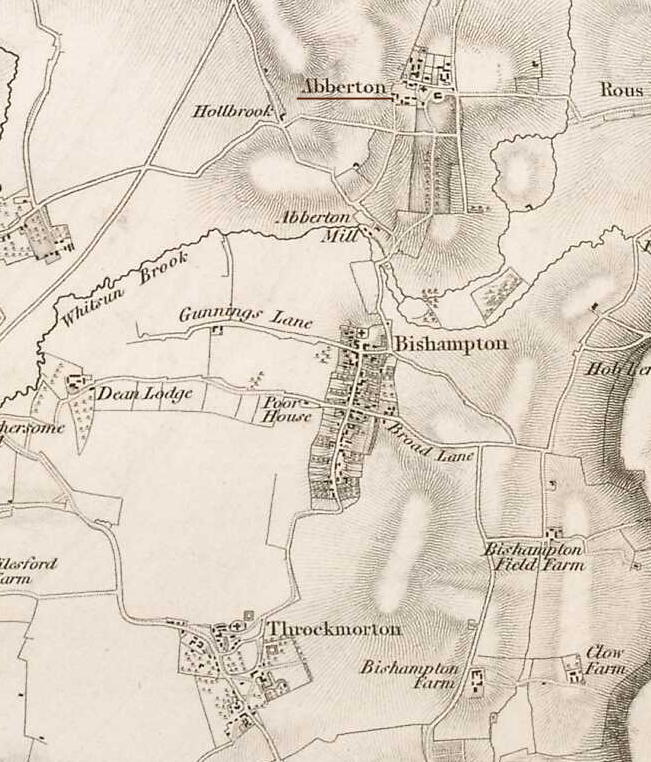
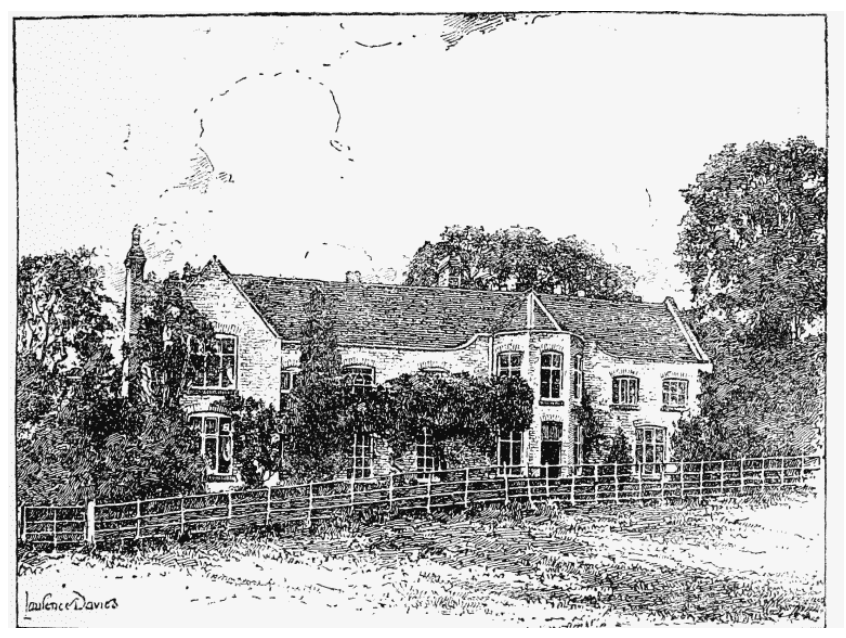
“[Abberton] manor was granted on 16 January 1544 to William and Francis Sheldon. Ralph Sheldon was then lessee of Abberton, which he also held in 1540, and it appears that he had been preceded here, as in his Beoley property, by his brother William, who died childless in 1517, and who is entered in the Visitation of 1569 as William Sheldon of Abberton. John Sheldon, father of William and Ralph, was also seated at Abberton. William and Francis Sheldon, grantees of the manor in 1544, were sons of this Ralph. The manor was settled on Francis Sheldon and Mary his wife, with remainder to their children, William, Thomas, Francis and Lucy. The William Sheldon to whom the grant of 1544 was made died on 24 December 1570, when William son of Francis was of full age and residing at Abberton. This William was succeeded in 1608 by his son Francis, a grant of the benefit of whose recusancy had been made to Henry Mynours in the previous year. Francis Sheldon and his wife Elizabeth were holding the manor in 1625 and 1632. Francis Sheldon, who was dealing with the manor in 1699, died in the following year, his son and successor Francis dying in 1711. Francis Sheldon, probably son of the latter, was holding the manor in 1720. In 1733 an Act was passed for discharging the estate at Abberton of Francis Sheldon, a lunatic, from the trusts of a former Act of Parliament, made for the payment of his debts, and for vesting other of his estates in trustees for the same purpose. The manor was held by Thomas Sheldon in 1776 and by Thomas and his wife Margaret in 1798In 1544 the manor was leased by the Abbot for 80 years at a nominal rent to William and Francis Sheldon. At the dissolution this was confirmed by royal grant in perpetuity. The Sheldon family held the manor of Abberton until 1798, when the then owner, Thomas Sheldon, sold it to John Hardcastle. A Francis SHELDON was high sheriff of Abberton in 1723 (had 3 daughters) and a Thomas SHELDON was a a church patron in 1772. ” from the History of Worcesterhsire Vol. 4
The church of St. Eadburgha of Abberton was rebuilt in the 19th C. “Under the tower are a number of slabs of the Sheldon family, including Samuel Sheldon, 1659, and Mercy, 1729, son and daughter of Francis Sheldon; Susanna wife of Francis Sheldon, 1719, with the arms Sheldon impaling Dormer; Francis Sheldon, 1700, with the arms Sheldon impaling Savage and several others. The plate consists of a cup and cover paten, both with the London mark for 1571, and a large paten of the 18th century, without date mark, but bearing the Sheldon arms —a fesse between three sheldrakes.” from the History of Worcesterhsire Vol. 4
Note: very nice early maps of Abberton here.
ROWLEY REGIS SHELDONs
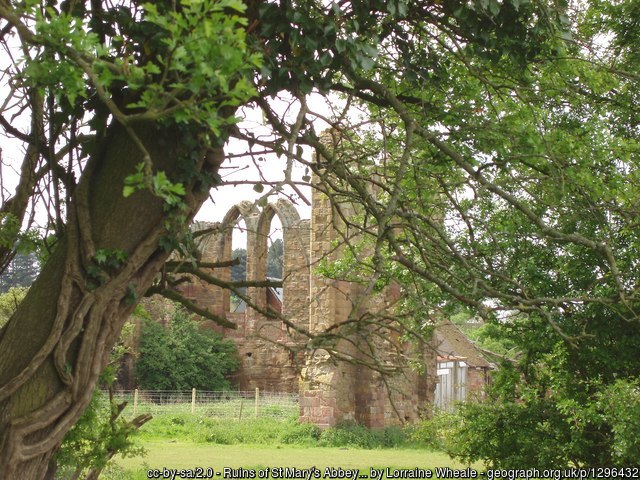
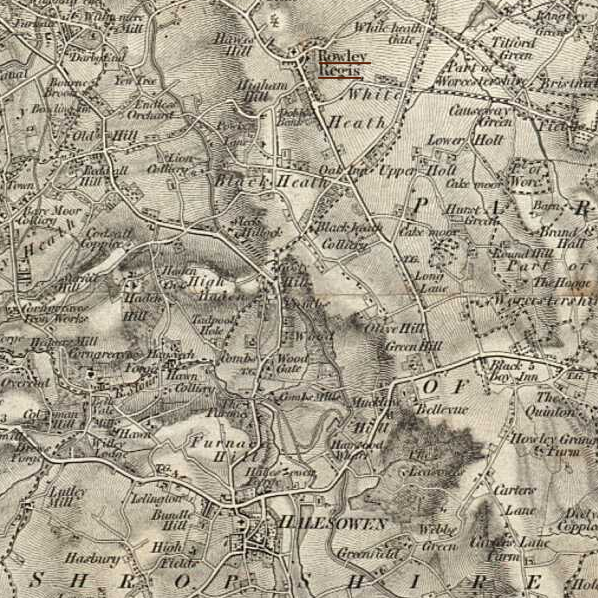
This is a very old branch of the SHELDON family established by a John SHELDON (c1350-1433) perhaps originally of Birmingham or the village of SHELDON. He was listed as a gentleman of Rowley 16 Jun 1419. He died in Rowley Regis. John SHELDON was the son of Thomas de SHELDON (1325-1433). Rowley was part of the Royal hunting grounds and Regis was added to the name around 1140 to signify it was that part of Rowley belonging to the King. The church of St. Giles Rowley Regis has been rebuilt a couple of times. Nothing of the original church remains.
John SHELDON (c1350-1433) had a son Ralph I SHELDON (Roffe) (c1375-1464) and a son Richard I SHELDON (c1390-) an attorney. Richard I had two sons Richard II SHELDON (1400-1495) and Morris or Maurice SHELDON (1428-1486)
BEOLEY SHELDONs
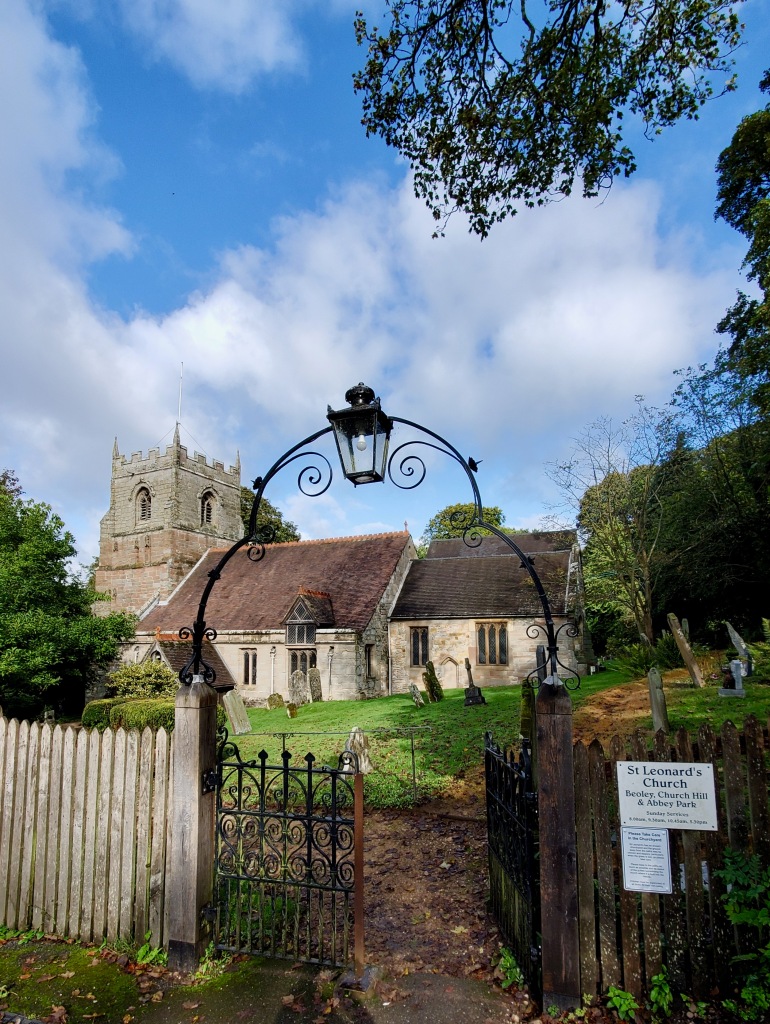
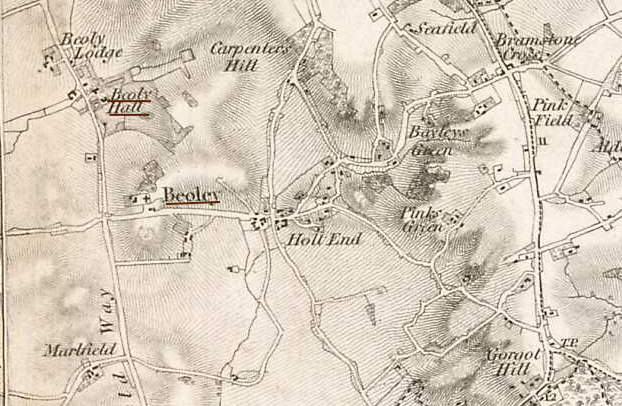
William SHELDON (1455-1517), the eldest son of Ralph SHELDON of Abberton, purchased the Worcestershire manor at Beoley from Richard Neville, Lord Latimer about 1470’s. They lived at Balford Hall which is no longer standing. “The former home of the Sheldons is locally said to have been destroyed during the Civil War of the 17th century, and the present house was erected some time after the Restoration, either on the same site or a little to the west of it. ” A history of Worcestershire Vol 4
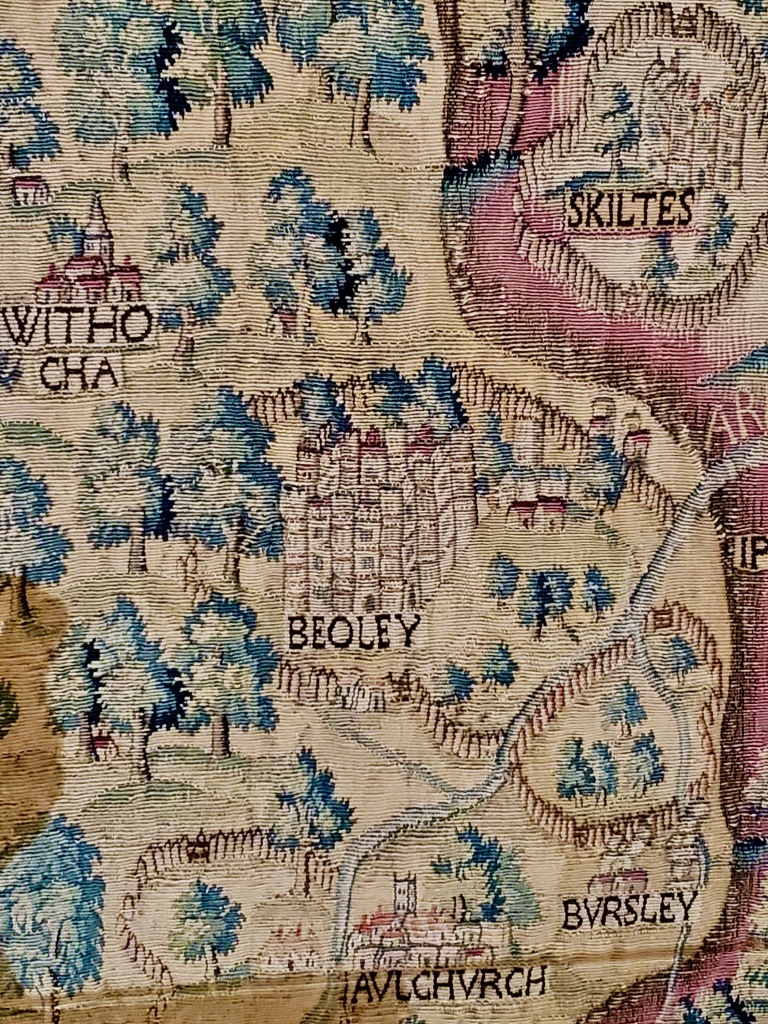
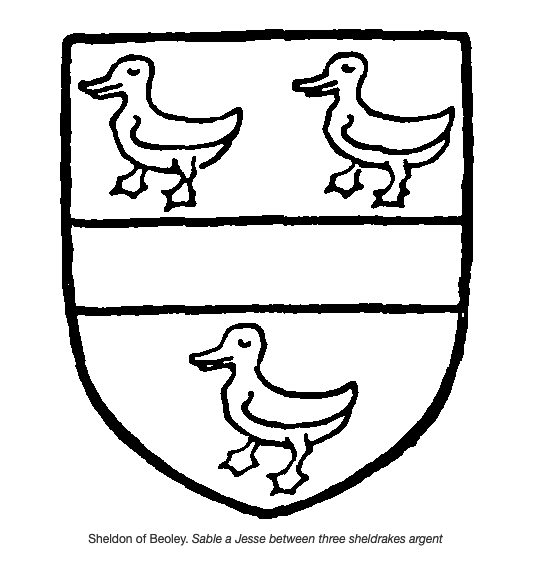
At St. Leonard’s Beoley you will find the SHELDON Chapel which has many monuments to SHELDONS. The two oldest tombs are for William SHELDON I (c1472-1517) the first resident Lord of Beoley (died unmarried) and his brother Ralph SHELDON (1475-1546) of Abberton.
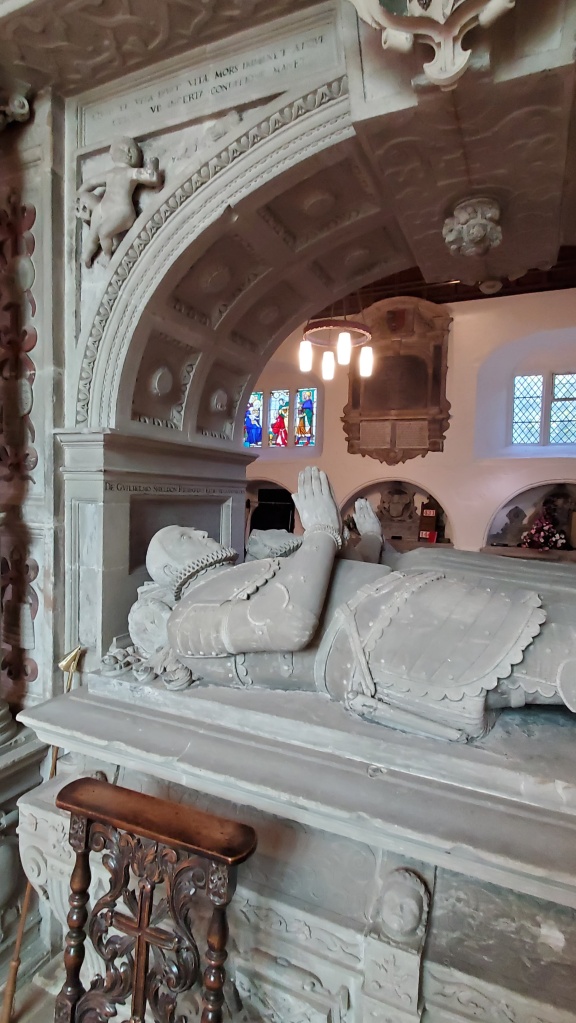
of brothers William and Ralph SHELDON beyond.
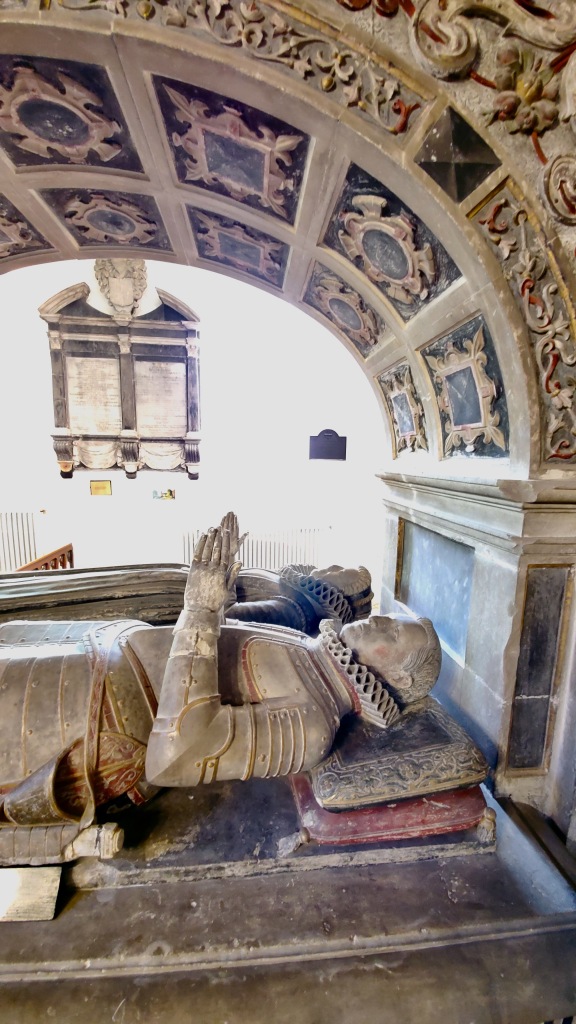
“William Sheldon had acquired in 1544 land in Beoley which had belonged to Alcester Monastery, and he further added to the family estates by marrying as his first wife Mary, eldest daughter and co-heir of William Willington of Barcheston (co. Warwick). Habington wrote of him that he ‘in our age for wysdome, estate, and authority in our county equalled most of the gentellmen of England.’ He is said to have been the introducer of tapestry weaving into England, bringing over at his own expense workmen from Flanders to his Barcheston estate, where they began by weaving maps of England in tapestry. He made a settlement of the manor at the marriage of his son Ralph with Anne one of the daughters of Sir Robert Throckmorton, on 16 May 1557, and died at Skilts Studley (co. Warwick), on 24 December 1570. He was buried three weeks later with great pomp at Beoley, where a splendid monument was erected to him later by his son and heir Ralph. In the library of the College of Arms is preserved his illuminated funeral certificate. He was succeeded by his son Ralph, who adorned the handsome Sheldon chapel, and filled it with monuments and effigies of his ancestors. He settled the manor on his son Edward, his brother William, and the heirs of his father William, in tail male successively, in 1575. In 1580 he was committed to the Marshalsea prison as a recusant, but was removed at the petition of his wife to the house of the Dean of Westminster for surgical treatment, he being afflicted with a disease to the ‘perill of his liefe.’ Early in the following year he promised ‘to yielde himself dutifull and obedient unto Her Majesty and in token thereof to be contented to repair unto the churche,’ but the benefit of his recusancy was granted to David Drummond as late as 4 March 1610. His son Edward, who succeeded him in 1613, married Elizabeth, daughter of Thomas Markham of Ollerton, ‘Black Markham,’ and died in 1643, when he was followed by his son William.
William Sheldon, who pleaded His Majesty’s letters of grace in bar of the laws against recusants in 1639, married Elizabeth, daughter of William, second Lord Petre, and Lord Petre was holding the manor, evidently for the purposes of a settlement, in 1648. As a Royalist, William Sheldon suffered heavily. His house at Beoley is said to have been burnt down to prevent it from falling into the hands of the Parliamentarians, and his estates were included among those of delinquents not permitted to compound from which £50,000 was raised for the relief of Ireland in 1648. In the course of numerous petitions dealing with Beoley, which was sequestered, he protested that he was never in arms, never acted for the king’s party except when forced, but was sequestered on sinister information. In 1650 the manor was conveyed by the Treason Trustees to John Wildman and George Day, who were holding it with William Sheldon and his sons Ralph and George in 1653, in which year the manor was discharged from sequestration. It seems then to have remained in the possession of George Day until the Restoration. William Sheldon died in 1659, and in 1660 George Day and Anne his wife conveyed Beoley to Richard Sheldon, presumably in process of restoring it to William’s son and successor Ralph Sheldon. Of Ralph Sheldon, Nash wrote that he was of ‘such remarkable integrity, charity, and hospitality as gained him the universal esteem of all the gentlemen of the county, insomuch that he usually went by the name of the Great Sheldon.’ A learned antiquary, he was also a munificent patron of learned men. He purchased and bequeathed to the College of Arms the manuscripts of Augustine Vincent, Windsor Herald. His own principal achievement was a ‘Catalogue of the Nobility of England since the Norman Conquest according to their severall Creations by every Particular King,’ with the arms finely emblazoned. As a reward for his devotion to the Royalist cause he was nominated a member of the contemplated order of the Royal Oak. He received licence to travel abroad for his health with six servants in 1667, and died in 1684. Being childless, and his brother Edward, a Benedictine monk at Douay, having refused to deal with secular matters, he bequeathed his property to his next heir male, Ralph Sheldon of Steeple Barton, co. Oxford., who made a conveyance of the manor in 1708. Ralph Sheldon died in 1720, and was succeeded by his son Edward, at whose death in 1736 Beoley passed to his son William. William was dealing with the manor in the same year, and in 1770, with his son and heir Ralph, barred the entail made at his marriage. William Sheldon was succeeded in 1780 by his son Ralph, who in 1788 sold the manor, then heavily mortgaged, to Thomas Holmes; Charles Sheldon, one of the six younger sons of William Sheldon, in the same year released the manor from payment of an annuity due to himself. A history of Worcestershire Vol 4
BARCHESTON SHELDONS
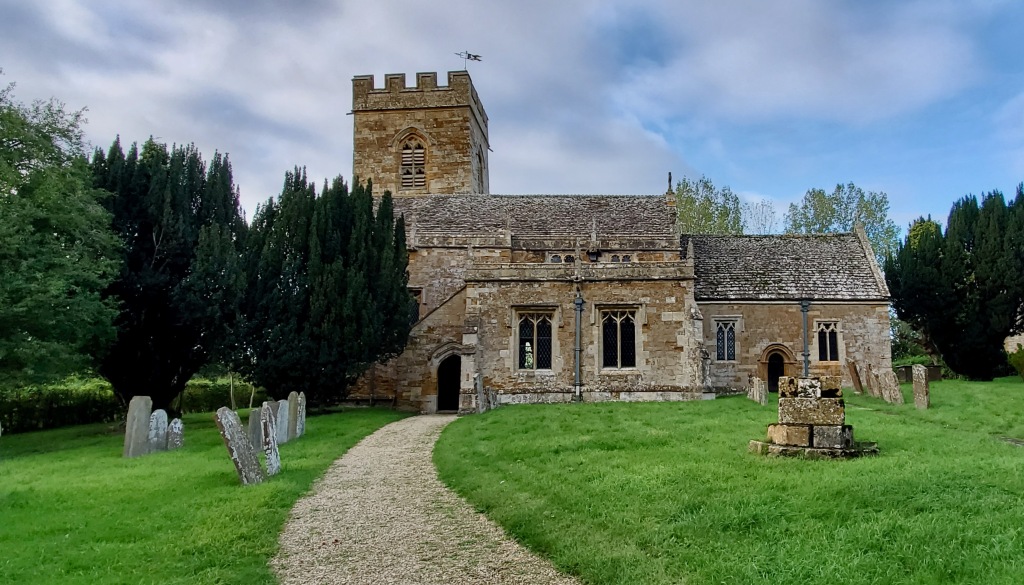
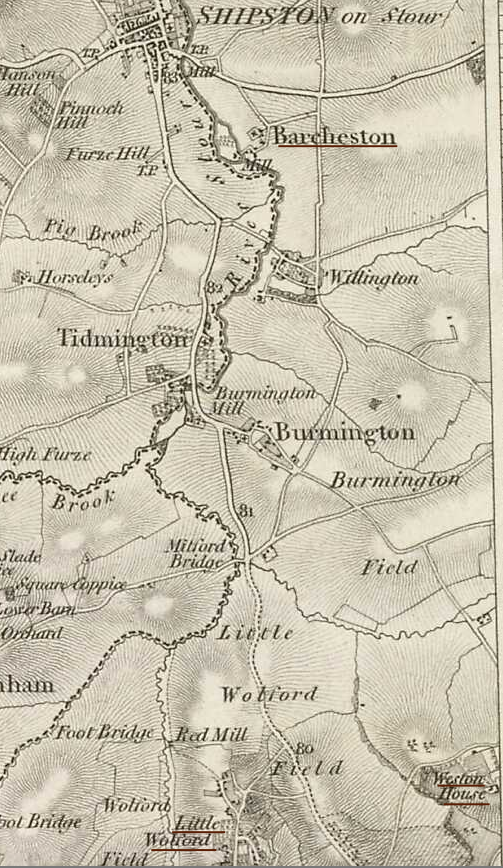
William SHELDON (1501-1575) married Mary Willington, the fourth daughter and co-heiress of the large estate of William Willington of Barcheston, Warwickshire. William and Mary SHELDON rest in a tomb at St, Martin’s Church, Barcheston beneath 16 C Alabaster effigies. Their son Ralph SHELDON (1537-1613) was responsible for the SHELDON Tapestries.
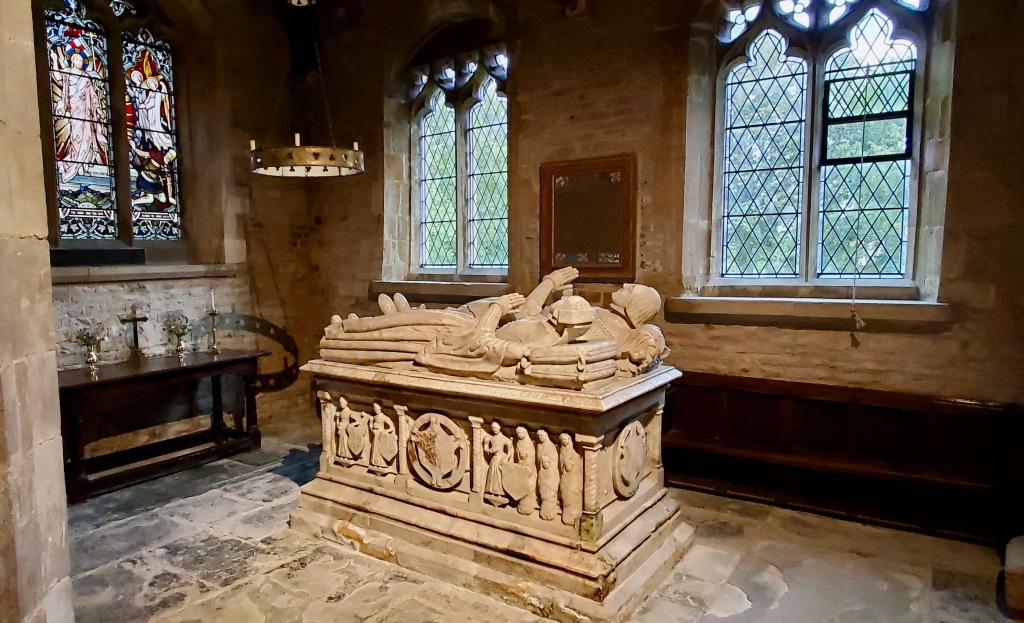
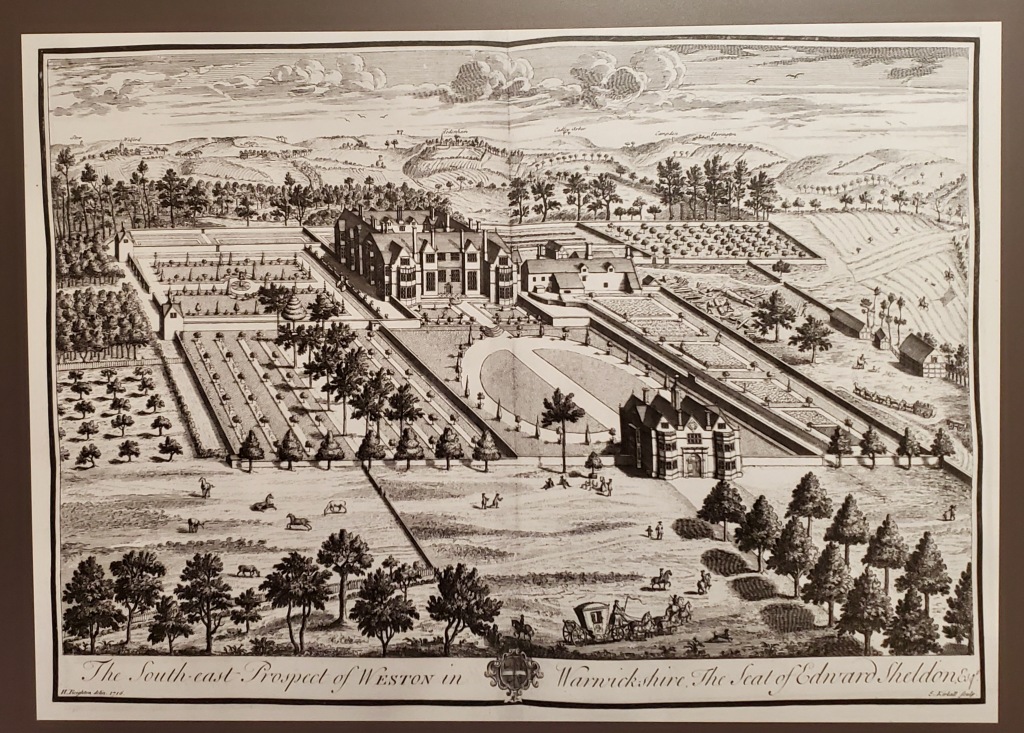
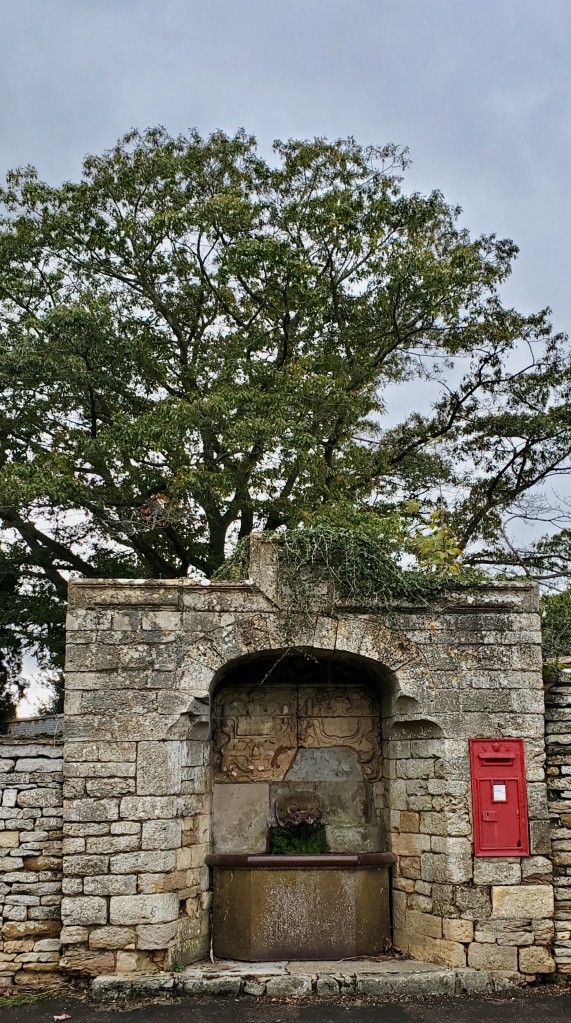
Ralph SHELDON (1537-1613) of Beoley and Weston. Nothing remains of Weston Manor but in nearby Little Wolford “in a wall on the roadside by the Manor House is a public drinking-fountain set in a recess partly made up of architectural fragments, including pieces of C15 windows and a number of early C17 carved stones, one of these being a broken shield of (Ralph) SHELDON impaling (Anne) Throckmorton of the original manor” from Our Warwickshire. (see heading for SHELDON Tapestries below)
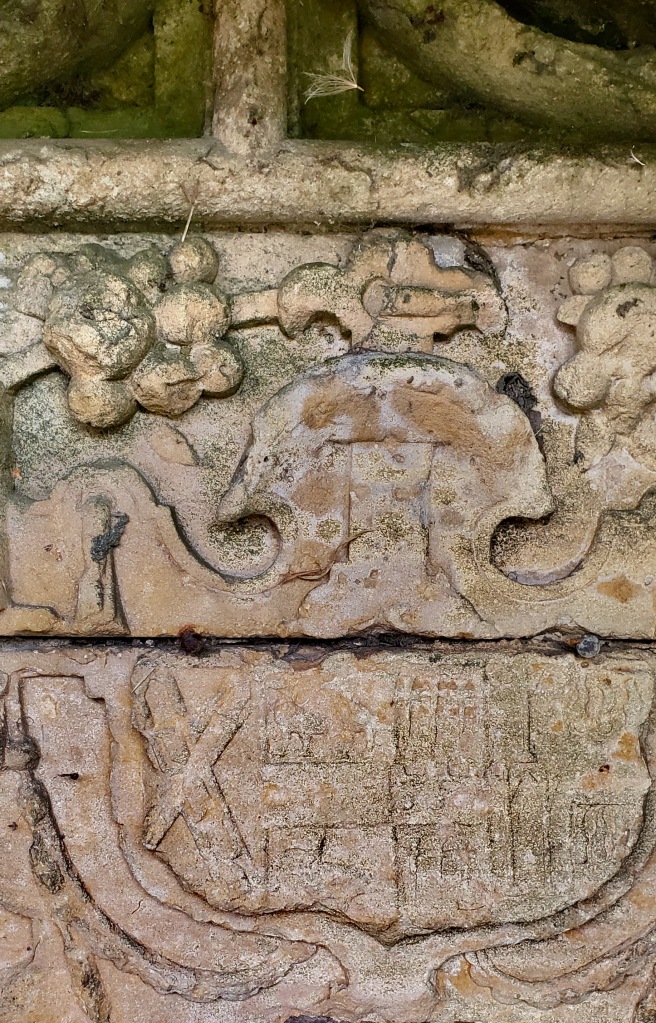
Ralph SHELDON (1537-1613) of Beoley and Weston had a son Edward SHELDON (1558-1643) who settled eleven miles SE of Weston in Steeple Barton, Oxfordshire. This Edward SHELDON (1558-1643) had two sons a William SHELDON (1589-1659) of Beoley and Weston and Ralph SHELDON (1592-1659) of Steeple Barton, Oxfordshire.
BROADWAY SHELDONs

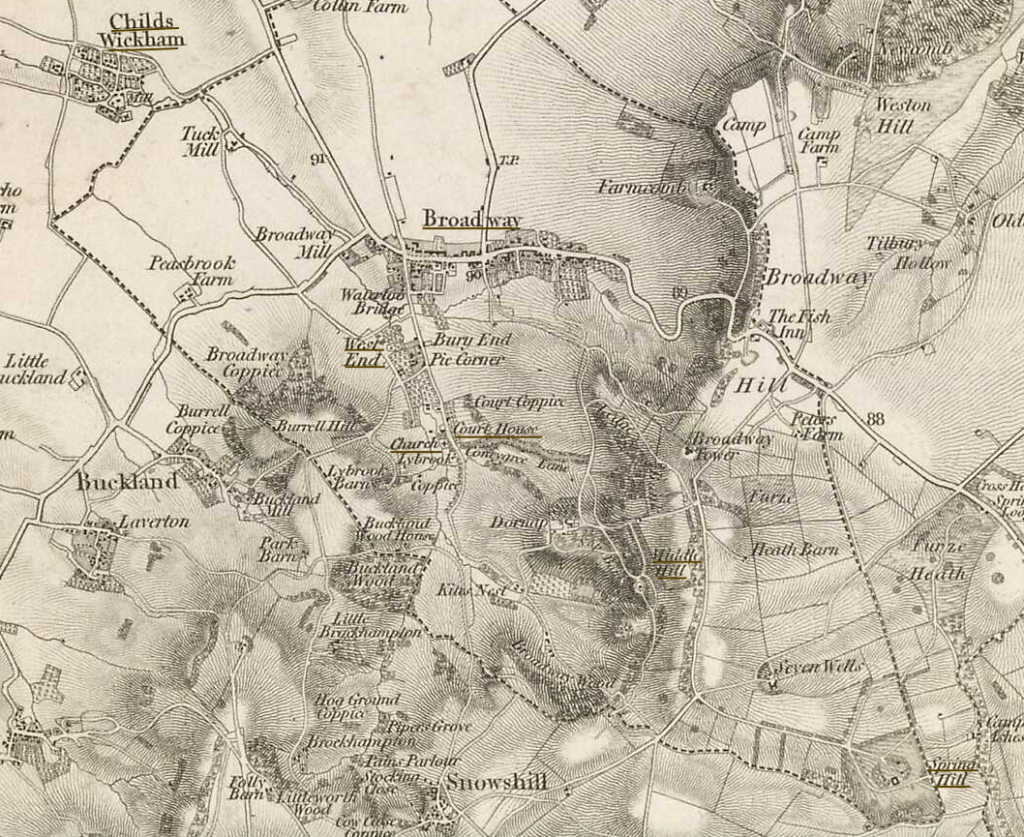
Showing Court House, (the Gate House would be across the road adjacent the church) Church, West End Middle Hill, Spring Hill and Childswickham
The founder of the Broadway branch of SHELDONs is Baldwin SHELDON the younger son of Ralph SHELDON (1475-1546) and Phillip Heath of Beoley. He had surviving sons Ralph SHELDON (1530-1586), Anthony SHELDON (1532-1584) and William SHELDON (1534-1576). Their first cousin was Ralph SHELDON (1537-1612) of the SHELDON Tapestries.
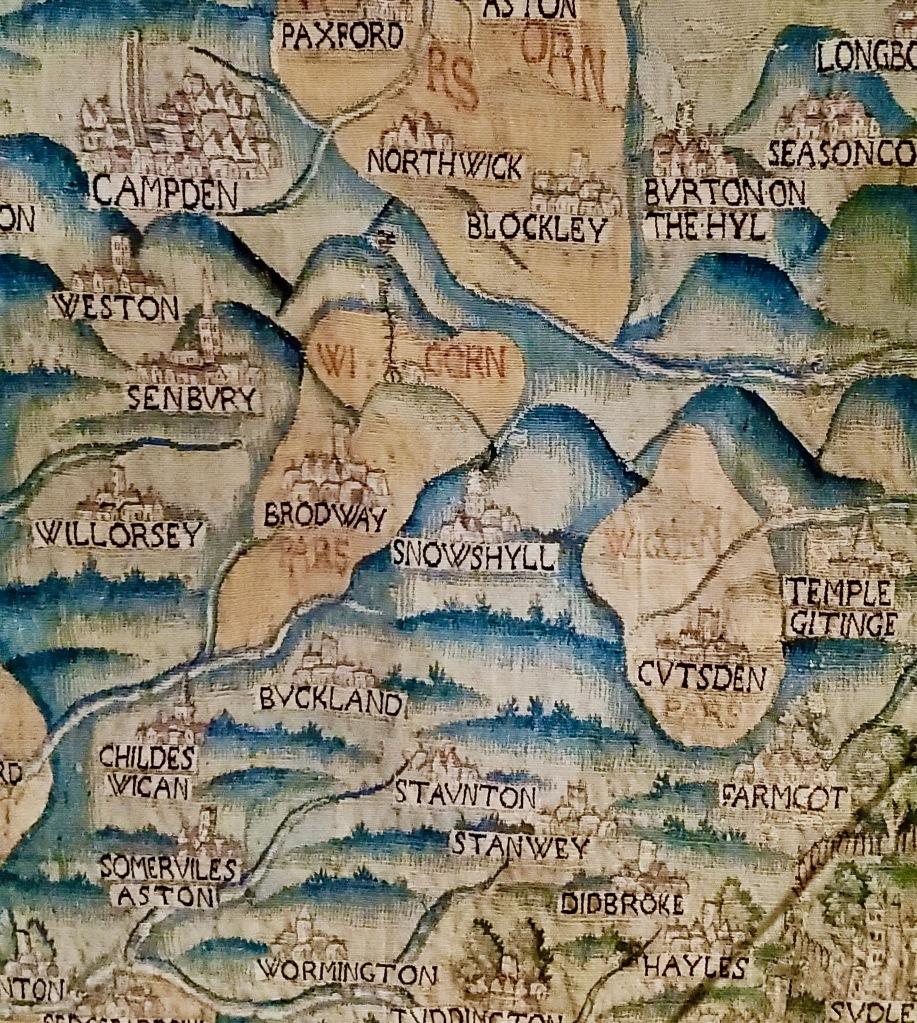
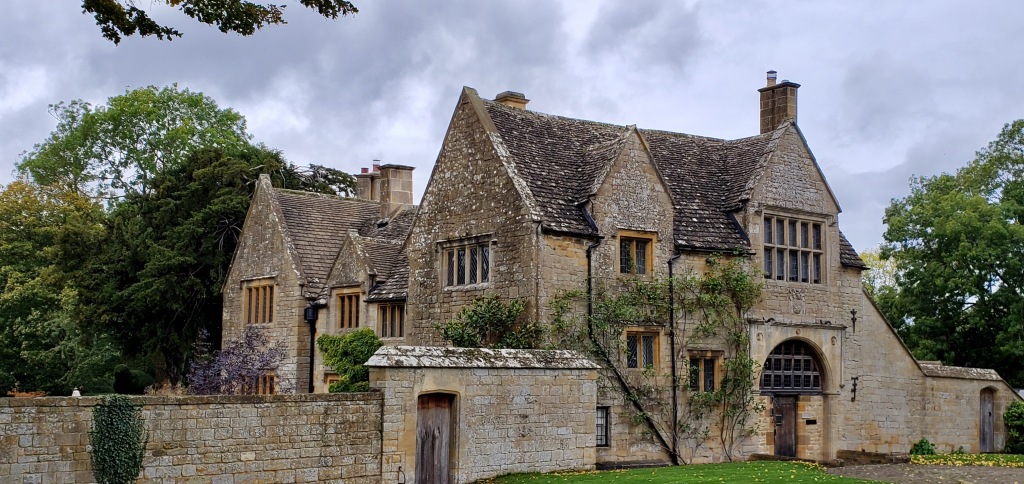
The Court House would have been the gate house of the original SHELDON manor land holdings. The holdings comprised 2,960 acres known as Broadway’s Great Farm. It included a dovecote, two gardens Broadway Court and the lands of Spring Hill and Middle Hill. “The old gate-house to Broadway Court, with modern additions on the west. The gate-house portion is a stone building of the late 16th or early 17th century, of two stories and an attic, with a stone-slate roof and stone-mullioned windows. The plan consists of a gateway with semicircular archways on the east and west, and the porter’s lodge to the south of and above it; the lodge retains its original four-centred doorways and fireplace and stone newel stairs. Above a square label over the east archway are the quartered arms of Sheldon, Sheldon quartering Ruding and Willington, and below the label are the crests of Savage, SHELDON, and Daston. The shield of Daston quartering Dumbleton, which is built into the modern west front, was found near the site of the old house, and fragments of low-relief carving of the late 16th or early 17th century are built into the garden wall which faces the road; these are embellished with foliated and heraldic ornament, and are probably from the porch or portico of the old house. Broadway Court itself has entirely disappeared, but its site is said to have been some distance to the east of this gate-house. ”
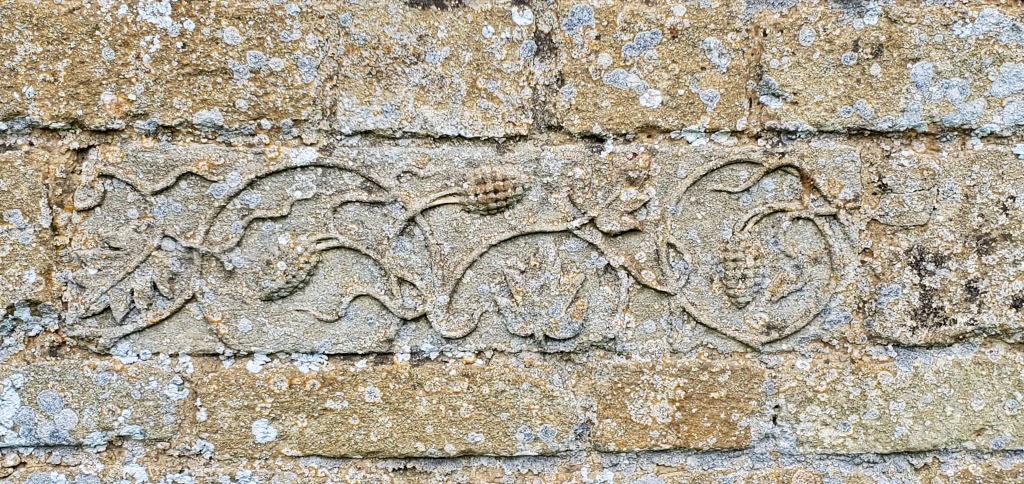
“The holdings were comprised of extensive fields and closes in Broadway Manor, and of the manor-house with its parlour and a chamber adjoining the kitchen, the gate-house with the granaries, two little houses within the gate-house, two stables, a bake-house, a house for the shepherd ‘sett or buylded nere unto the parysshe churche,’ a sheep-house by the churchyard and another near the Wheat Furlong.”
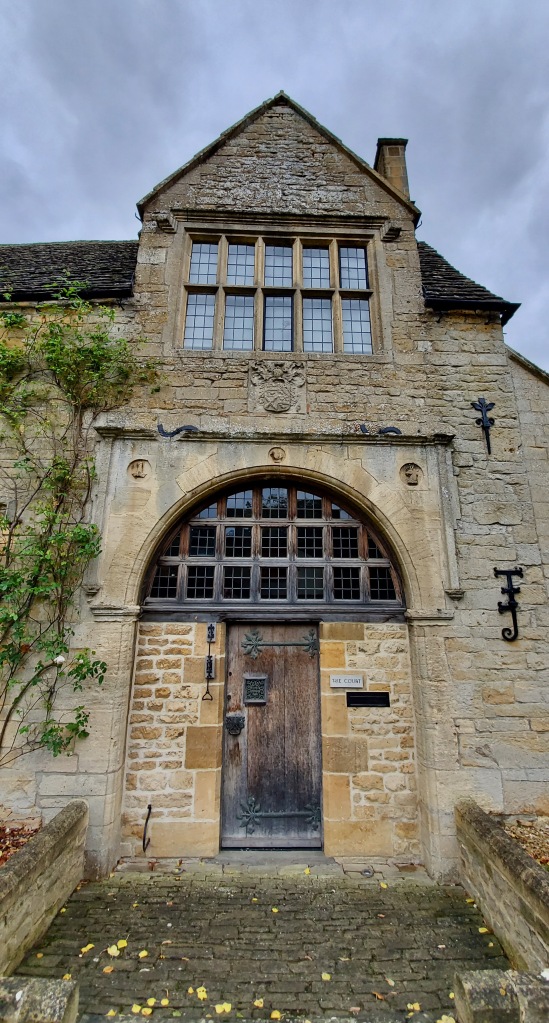
“The farm of the rest of the manor, including fisheries, fowling, warren and woods, was held by Ralph Sheldon under a lease from the abbot dated 5 September 1538 for a term of eighty years. In 1558, however, William Babington acquired from Queen Mary the fee simple of the whole manor at a twenty years’ purchase. Sir William Babington, grandson of the purchaser of the manor, sold it in 1576 to Ralph Sheldon, the former owner of a lease of part of the property, and to William Childe of Pensax, who was the husband of Sir William’s daughter Elizabeth. William Childe appears to have held the manor jointly for his life with Ralph Sheldon, and in 1595 he united with him in a settlement of the property on Sheldon’s nephew William, but after this date there is no further mention of him or his heirs in connection with Broadway. Ralph Sheldon survived his only son Thomas, who died in 1593, leaving two daughters. In 1576 Ralph Sheldon and William Childe granted a capital messuage and land at Broadway to Anthony, Ralph’s brother. Anthony died in 1584, when his son William succeeded to his estate. In 1595, two years after his son Thomas’s death, Ralph Sheldon settled the whole manor on this William. During his possession of the estate Ralph sold various messuages and lands. Most of these conveyances occurred in 1577, when he sold a house and land to Nicholas Blaby, the husband of his sister Jane. Nicholas was succeeded in 1593 by his grandson Ralph son of John Blaby. William Sheldon held the manor and a capital messuage in the Westend of Broadway until his death in 1626, when his son, another William, inherited. In 1678 the manor was still held by the Sheldons, William Sheldon then conveying it to John Barcroft, in trust, to be sold for the benefit of his children after his death, which occurred in 1680. ”
“In 1777 by George Savage, a descendant of Walter Savage bought the estate. The house at Middle Hill was enlarged and altered by Mr. Savage, who pulled down Broadway Court for the purpose.” from The History of the County or Worcestershire Vol IV 1924

The Broadway Manor Cottages have original fish ponds and a later agricultural building bearing the SHELDON Coat of Arms. The date of the building is 1768 but the COA may be from a much earlier building. This is probably the messauge mentioned on the west end in the above excerpt, held by William SHELDON.
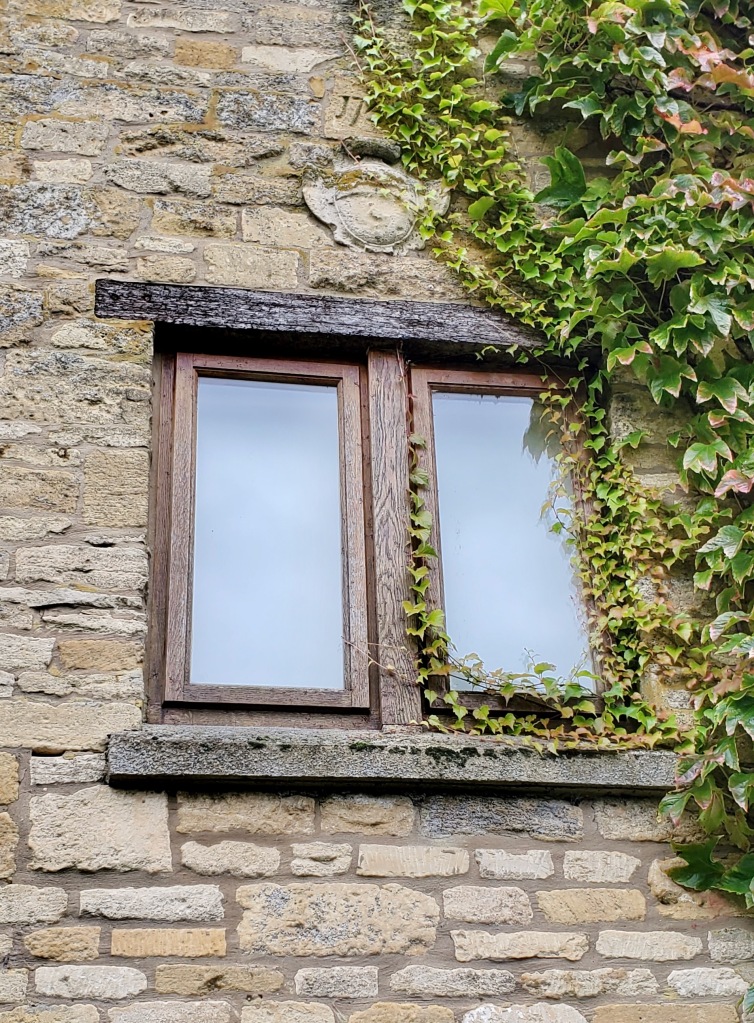
SPETCHLEY SHELDONs
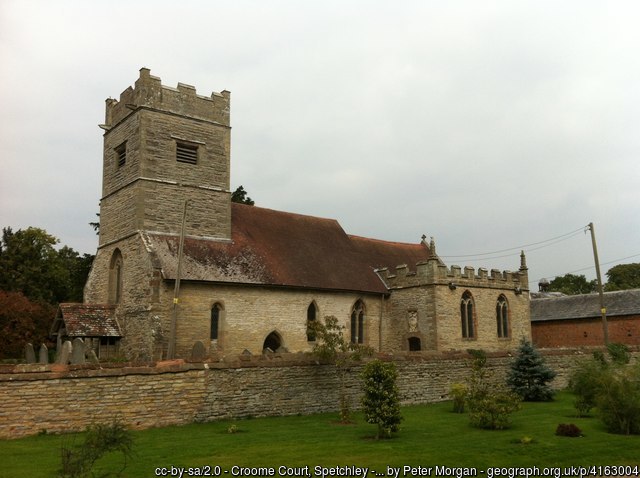
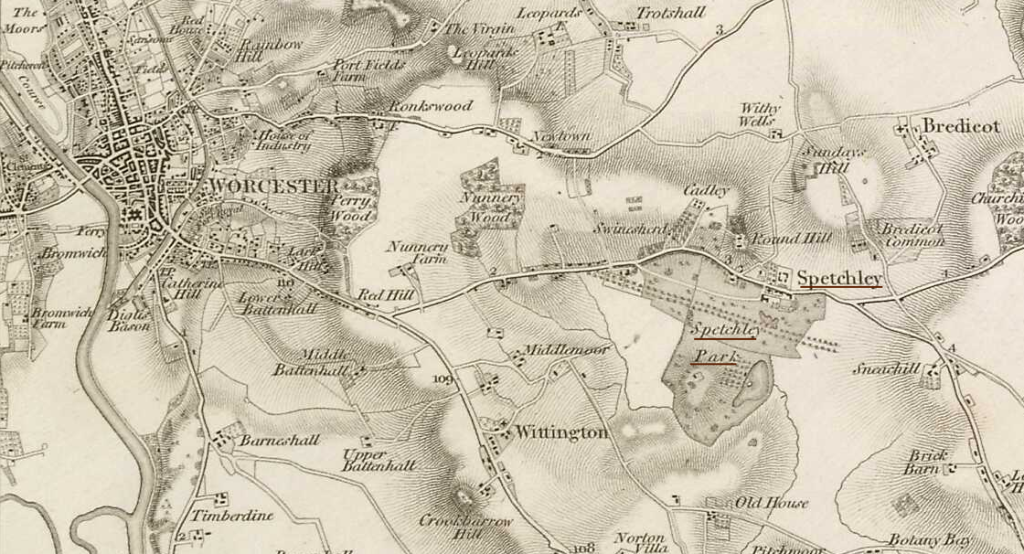
The Spetchley SHELDONs, a branch of the Beoley SHELDONs, founded by Daniel SHELDON the younger son of Ralph SHELDON (c1477-c1505) and his wife Joyce Ruding. Daniel married Eleanor daughter of John Grove of Grove Hall, Warwickshire and had Richard SHELDON (1520-1562) of Spetchley. Richard SHELDON married Catherine Lyttelton and from her brother John he obtained a lease of the lands and manor of Spetchley for 99 years in 1544–5. Richard SHELDON in “his will, proved in February 1562, left it to his wife Margaret for her life or as long as she remained unmarried, with reversion to Philip, his eldest son. The latter with his wife Elizabeth and son William sold Spetchley in 1606 to Rowland Berkeley, a clothier of Worcester.” A History of the County of Worcester: Volume 3. The original Spetchley Hall no longer stands and has been replaced with a Georgian style manor. The original residence was a moated Tudor house, situated to the south of the present house. It was burned to the ground in 1651 by disgruntled Scottish Presbyterian Royalists at the Battle of Worcester to prevent Oliver Cromwell from using the house as his headquarters.
Richard SHELDON (1520-1562) had two sons by his wife Catherine: Philip (c.1550) and Walter (c.1560) and three daughters: Frances, Cicely and Jane. The eldest son Philip SHELDON (1550-1610) married Elizabeth Slade daughter of John Slade. Phillip had three sons William (1586), Philip II (1590) and Richard (1593). As above it is Phillip I who sold the estate at Spetchley and removes to Manston, Dorchester, Dorset.
STEEPLE BARTON
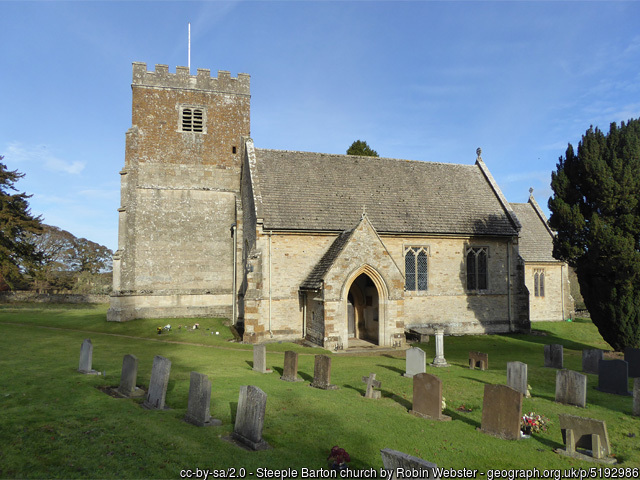
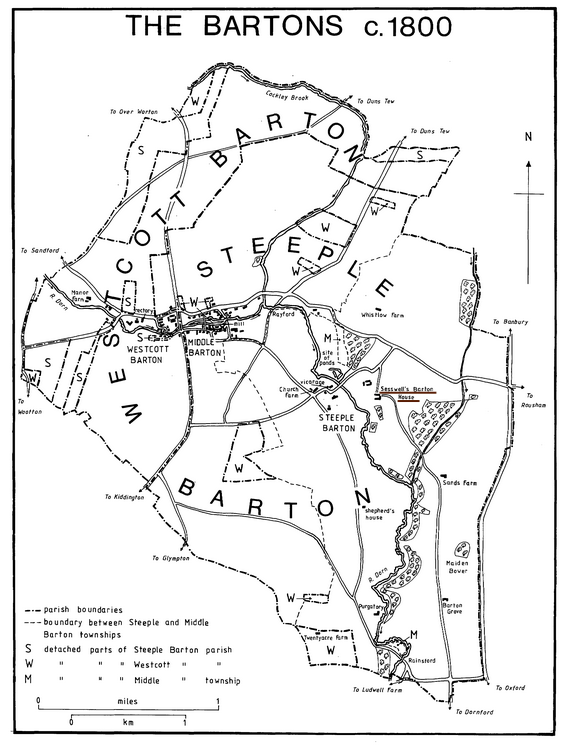
Edward SHELDON (1561-1643) of the Beoley and Weston SHELDONs settled eleven miles SE of Weston in Steeple Barton, Oxfordshire. He had two sons a William (1589-1659) of Beoley and Weston, and Ralph SHELDON (1592-1659) of Steeple Barton, Oxfordshire who married Bridget Morgan. In turn Ralph has one son Edward SHELDON (1624-1676) of Steeple Barton who married Catherine Constable. Edward SHELDON had a son Ralph SHELDON (1652-1720) who married Mary Anne Elliot . They had fours sons two were Jesuits. Their son Edward (1679-1736) married Elizabeth Shelley.
The manor house of Sesswell’s Barton: “Before 1605 Savage and Daston sold the property to Ralph SHELDON (d. 1613). Ralph’s son Edward in 1604 bought the remaining quarter from William Bustard of Adderbury.” The manor remained in the SHELDON family until the late 18th century, passing from Edward (d. 1643) to his second son Ralph (d. 1659), to Ralph’s son Edward (d. 1676), to Edward’s son Ralph (d. 1720), to Ralph’s son Edward (d. 1746), and to Edward’s son William (d. 1780); William’s son Ralph sold it in 1782 to Thomas Willan. Ralph Sheldon in 1678 considerably altered the interior, perhaps creating the great parlour, the withdrawing room, and the great staircase recorded in 1685; the staircase survived in 1980. In the 17th century the papist Sheldon family may have had a chapel in their house at Sesswell’s Barton. Ralph Sheldon and four of his household refused to take the protestation oath in 1641; his son Edward, his wife and three servants, with four others were reported as recusants c. 1663, and Edward’s son Ralph and his household were among the 10 recusants reported in 1682.” A History of the County of Oxford: Volume 11, Wootton Hundred (Northern Part).
TEMPLE GRAFTON
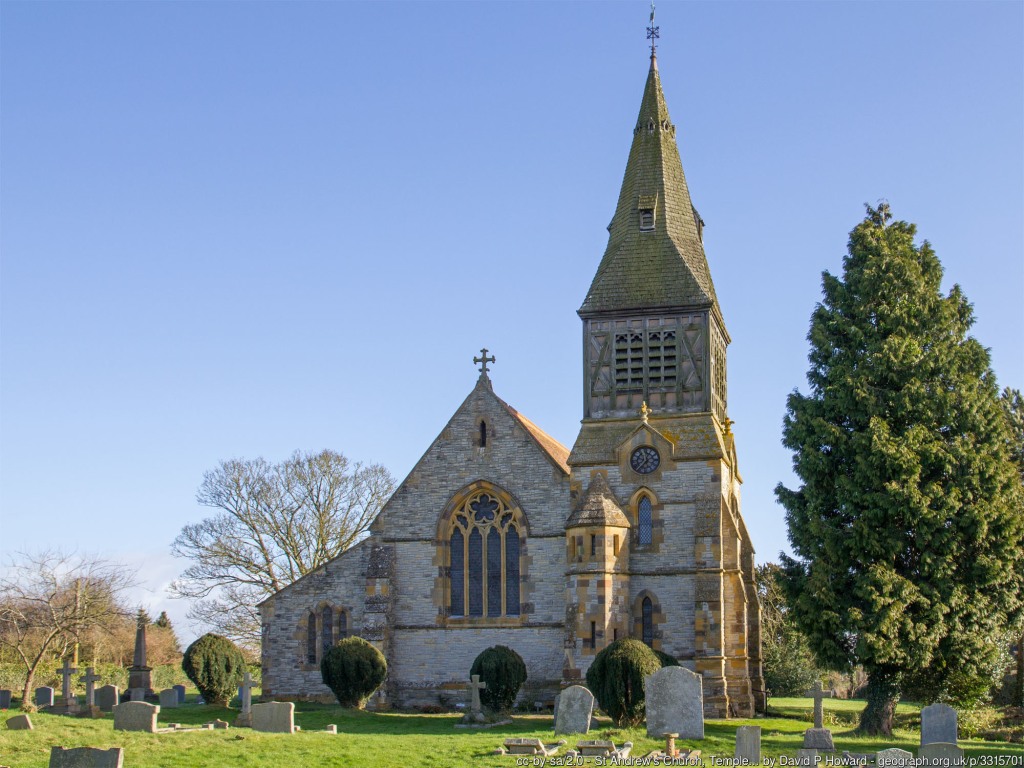
Many scholars believe this to be the place where William Shakespeare married Anne Hathaway, since records of the marriage do not appear in Stratford itself, and a license was issued for Shakespeare to marry in Temple Grafton. However marriage records for the period have been lost
The manor of Temple Grafton in 1545 was granted with other estates to William Sheldon and John Draper (alias Mercer) of Temple Grafton. It was allotted to Draper two years later. The original moated manor house is no longer extant being replaced by a 19th C Gothic manor. “In 1548 Draper settled the manor on his son Robert, reserving a moiety to his wife Margery for her life, and he died in 1556. Margery Draper died in 1558 and Robert in 1563, leaving a son and heir William, who received the manor on coming of age in 1583. William Draper married Margaret daughter of Anthony SHELDON of Broadway and, having no issue, settled the manor on Brace (or Blaze) SHELDON, his brother-in-law. (The Christian name Brace originated from the marriage of William Sheldon to Cicely daughter of Francis Brace of Doverdale. Blaze appears to have been the usual form after c. 1650) From him it passed to his son and grandson, both also named Brace. Brace II, who was found seised of the manor in 1626, was a recusant, and in 1633 two parts of his lands here forfeited to the Crown were granted to his kinsman, William SHELDON, on a lease for forty-one years. Brace III was holding the manor in 1654 and died c. 1669, leaving his daughter Anne as his heir. His younger brother Ralph, who appears as lord of the manor in 1674 and 1675, may have been acting as guardian during Anne’s minority.” In the Church of Temple Grafton St. Andrew on the N wall of the chancel is a repainted stone shield of arms of the 17th century with the six quarterings of the Woodchurch-Clarke family, impaling the quarterly coat of De la Hay, Winterbourne, Sheldon, and Ruding.
WEDNESBURY
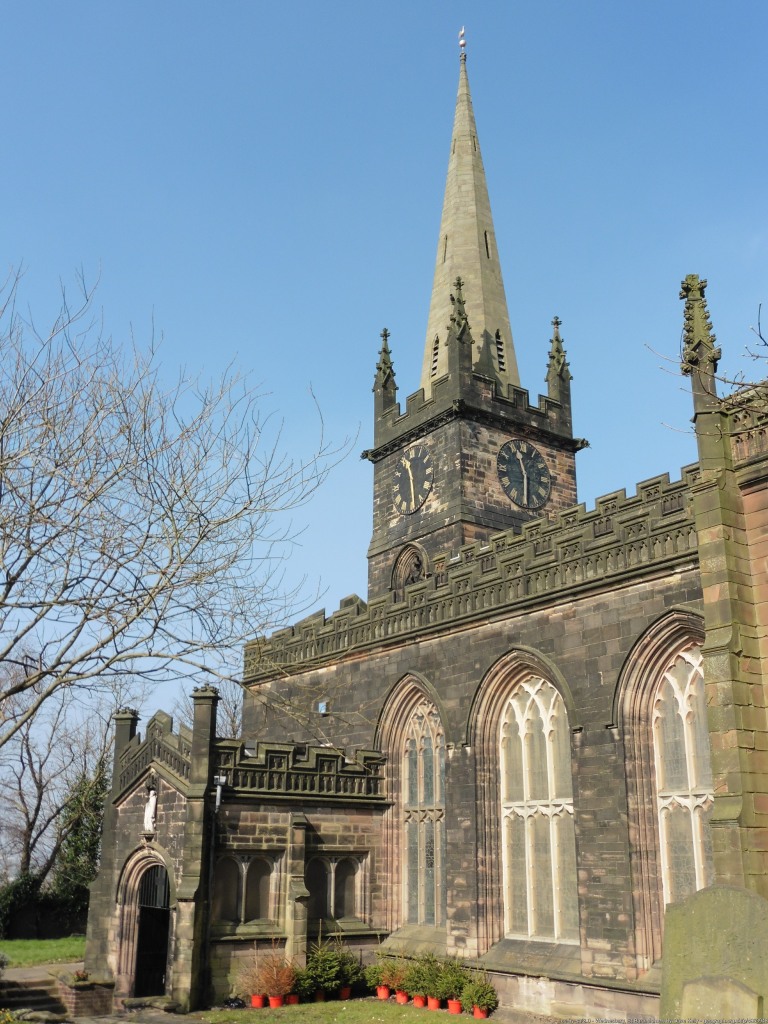
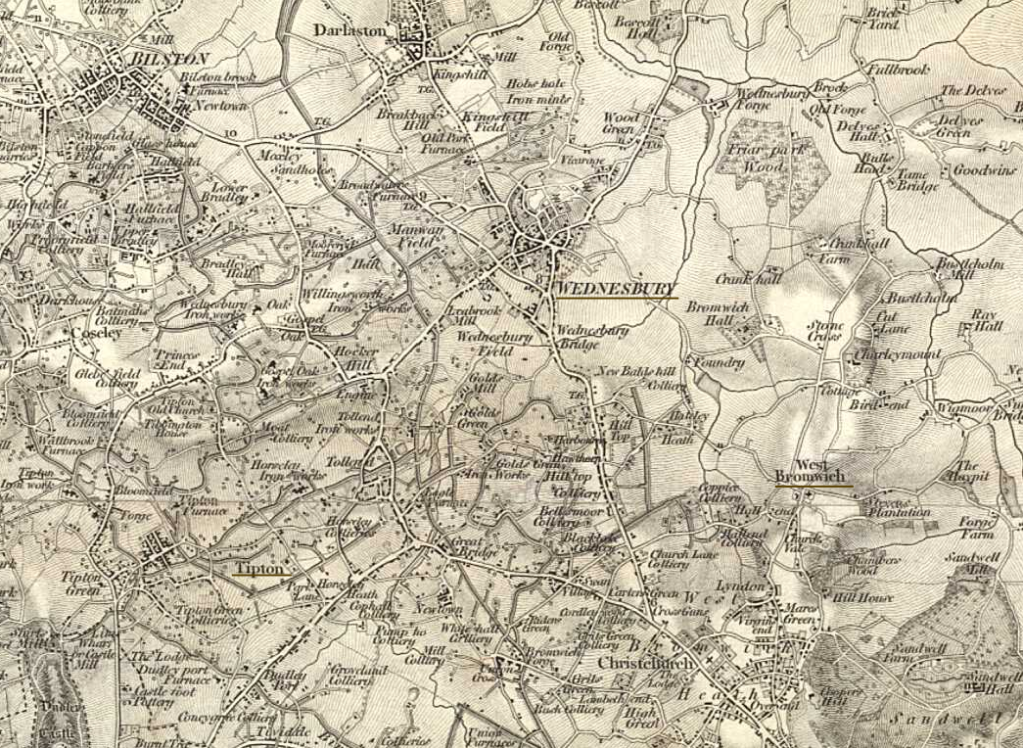
The distance from Wednesbury to West Bromwich and to Tipton is about 4 miles. Tentenhall is about 7 miles NW. Sometime in the reign of Elizabeth I (1558-1603) Richard SHELDON & Thomas SHELDON were defendants in a property dispute over Wednesday Manor formerly the estate of John Beaumont. The Manor of Wendesbury is believed to have been located about 300 yards NE of St Bartholomew’s Church in Wednesbury. Later it appears that Henry was a tenant of a messauge of Wednesbury Manor. In 1597 Richard, Thomas and Henry SHELDON are all listed as yeoman of Wednesbury. Richard SHELDON (c1535-1613) m Isabel Russel and owned land in Wednesbury in 1590. He died 9 Sep 1613 in Wednesbury. Richard had a son Henry (1566-1619) who married Anne Parke. They had children baptized at Wenesbury: Isable 15 July 1588, Eleanor 25 Dec 1589, Richard 19 Sep 1590, Thomas 11 Mar 1592, George 14 Sep 1595 and Elizabeth 13 Mar 1596.
First appearance in the parish Register for Tipton is a Thomas SHELDON baptized 8 July 1599 son of Thomas SHELDON, followed by Elinar 11 Apr 1602 and John 12 Apr 1611.
In Tettenhall we find Michael SHELDON having a son Michael Baptized 5 Jan 1605. Beginning in 1606 we have a Thomas SHELDON in Tettenhall having children baptized: Richard 27 July 1606, Edward 5 May 1609, Jane 16 Aug 1612, and Anne 14 Jan 1616. A Richard SHELDON appears to have one daughter Sara baptized also in Tettenhall 23 July 1609. William SHELDON has one daughter baptized 23 Mar 1606 Margaret. And Finally a John SHELDON in Tettenhall has the following children Baptized: Margarie 24 Jan 1611, Anne 22 Apr 1614, and John 30 Nov 1620.
SHELDON TAPESTRIES
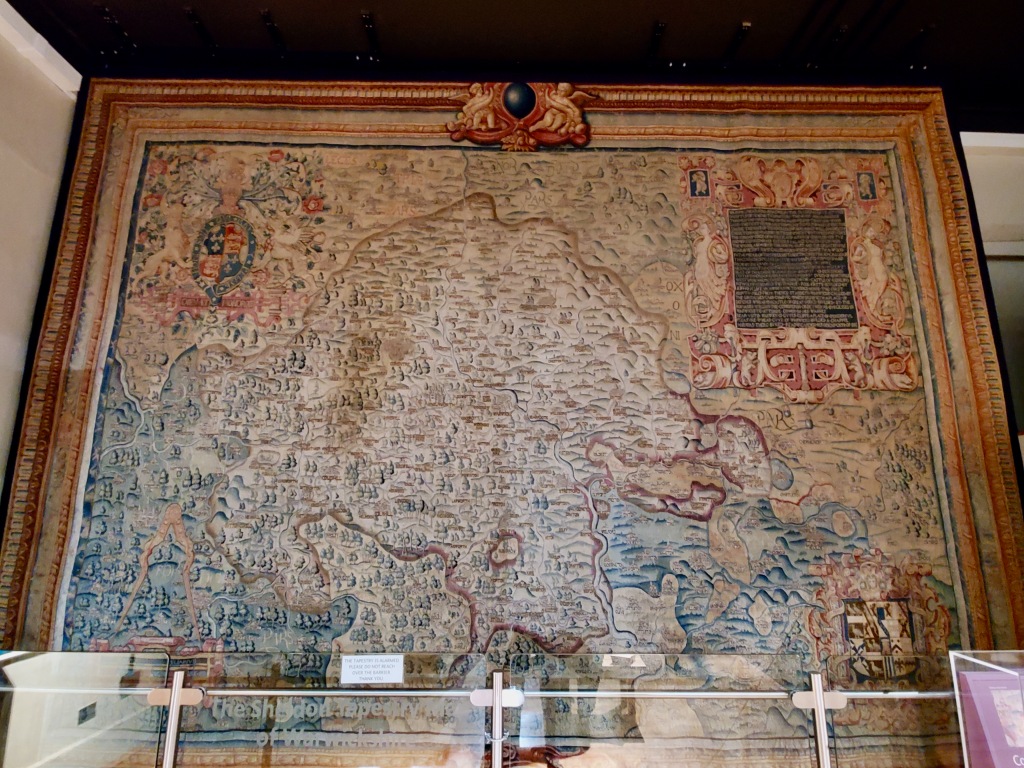
We do not know if the Warwickshire branch of SHELDONs are related to any of the American SHELDONs, but all SHELDONs may be interested in the SHELDON Tapestries. There are 4 extant SHELDON tapestries the largest intact version is located in Warwick at the Market Hall Museum (above photo) is of Warwickshire made in 1588. Three others are held at the Bodleian Library at Oxford and include Oxfordshire, Worcestershire and Gloucestershire. These tapestries were commissioned by Ralph SHELDON (1537-1613) of Beoley and Weston. It is interesting to note that the places associated with SHELDONs appear grandly depicted on the tapestry. This tapestry is 20′ X 13′ and was to hang in Ralph SHELDON’s manor at Weston (see above illustration of Weston Manor under Barcheston). Interesting that Flemish weavers were imported to work on the Tapestries and that the portrait below was done by a Flemish painter.
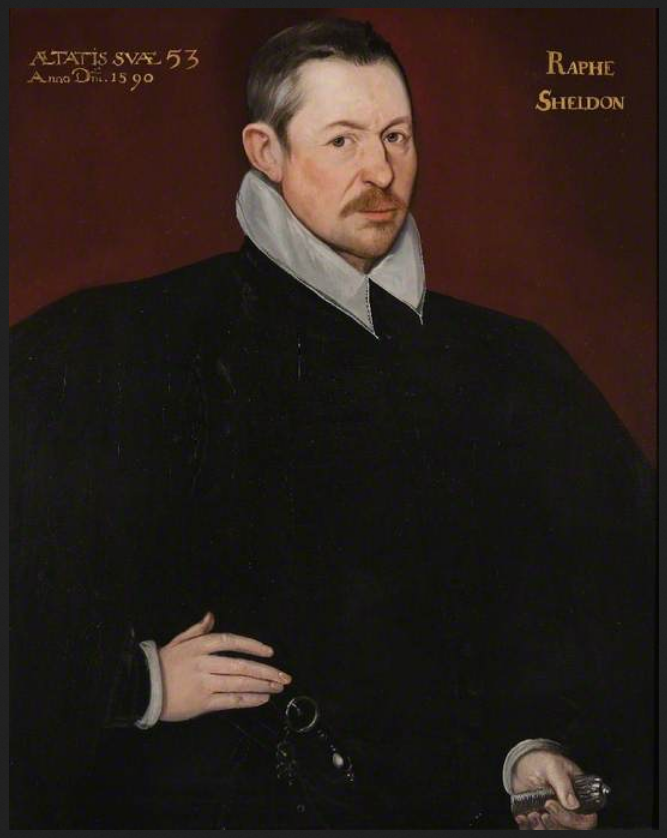
Below is a part of the SHELDON tapestry for Warwickshire.
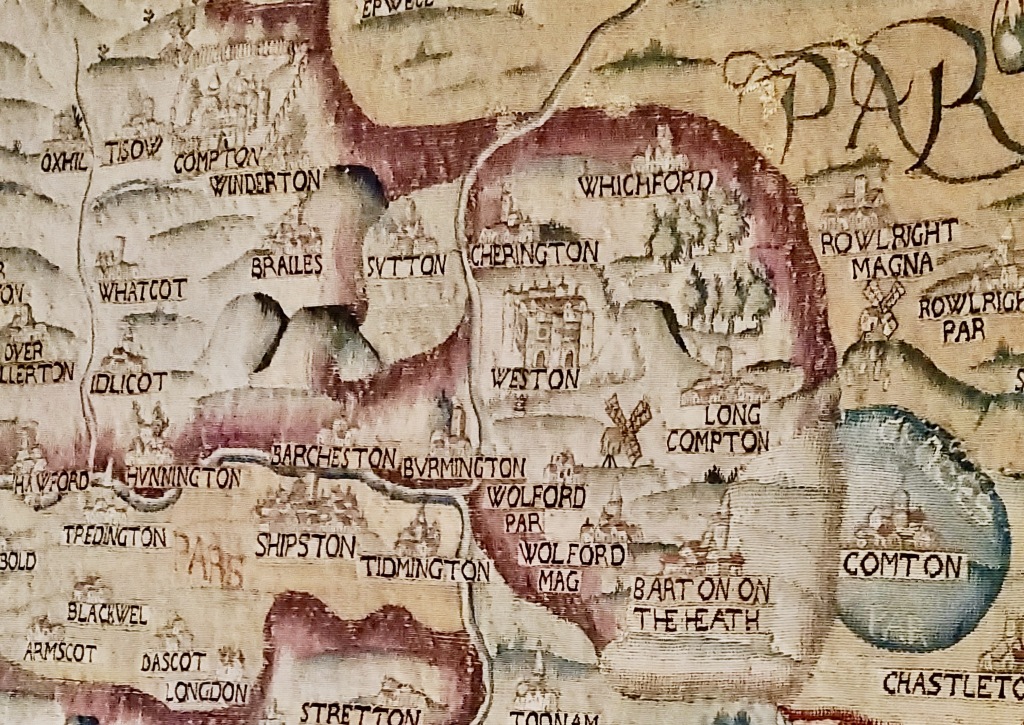
Below is lovely detail from the Gloucestershire Tapestry held by the Bodleian Library at Oxford.
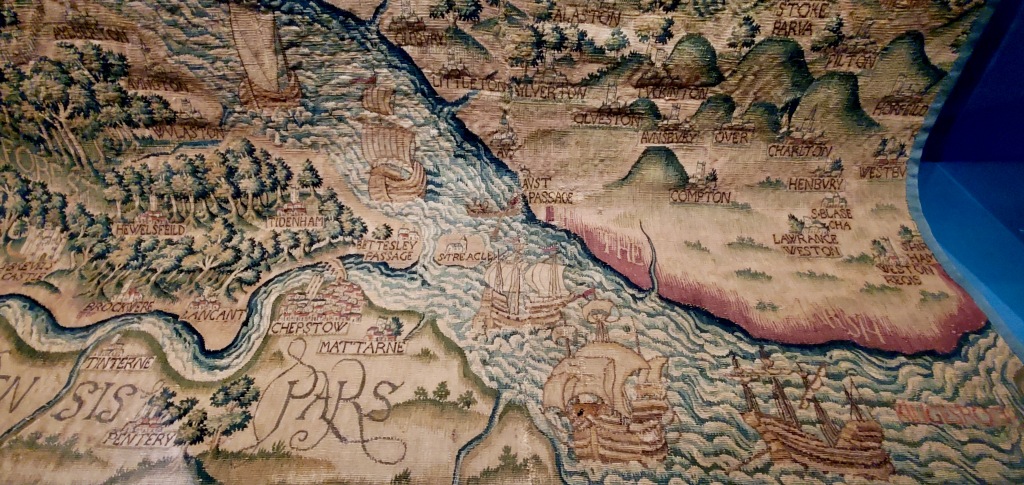
And finally a piece of the Oxfordshire Tapestry showing London also held by the Bodleian Library at Oxford.
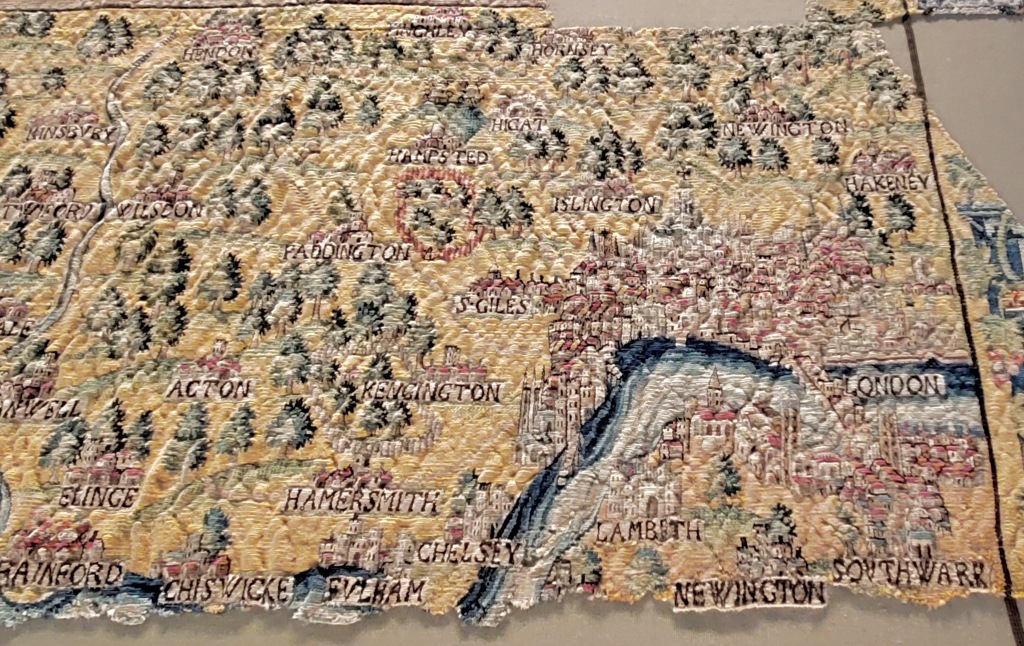
Additional images of Sheldon tapestries are available at the Victoria & Albert Museum in London here.
Kelly Wheaton Copyright 2020. All Rights Reserved.